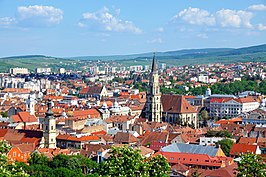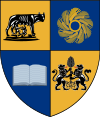Cluj-Napoca
Cluj-Napoca | |
|---|---|
From top and left: Cluj-Napoca panorama • St. Michael's Church • Dormition of the Theotokos Cathedral • Medieval house of Matthias Corvinus • Romanian National Opera • Babeș-Bolyai University | |
|
trams, utility vehicles, ATVs , etc.) |
Cluj-Napoca (Romanian:
As of 2021[update], 286,598 inhabitants lived within the city limits (making it the country's second
Cluj experienced a decade of decline during the 1990s, its international reputation suffering from the policies of its mayor at the time, Gheorghe Funar.[11] Today, the city is one of the most important academic, cultural, industrial and business centres in Romania. Among other institutions, it hosts the country's largest university, Babeș-Bolyai University, with its botanical garden; nationally renowned cultural institutions; as well as the largest Romanian-owned commercial bank.[12][13] Cluj-Napoca held the titles of European Youth Capital in 2015,[14] and European City of Sport in 2018.[15] In 2021, the city joined the UNESCO Creative Cities Network and was named a UNESCO City of Film.[16]
Etymology
Napoca
On the site of the city was a
Cluj

The first written mention of the city's current name – as a Royal Borough – was in 1213 under the
The
Other historical names for the city, all related to or derived from "Cluj" in different languages, include
Current official name
Napoca, the pre-Roman and Roman name of ancient settlements in the area of the modern city, was added to the historical and modern name of Cluj during Nicolae Ceaușescu's national-communist dictatorship as part of his myth-making efforts.[25] This happened in 1974, when the communist authorities made this nationalist gesture with the goal of emphasising the city's pre-Roman roots.[26][27] The full name of "Cluj-Napoca" is rarely used outside of official contexts.[28]
Nickname
The nickname "treasure city" was acquired in the late 16th century, and refers to the wealth amassed by residents, including in the precious metals trade.[29] The phrase is kincses város in Hungarian,[2][30] given in Romanian as orașul comoară.[1]
History
Roman Empire
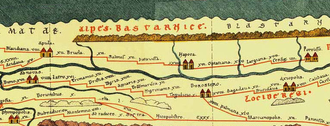
The
Middle Ages
Kingdom of Hungary 1000–1526
Eastern Hungarian Kingdom 1526–1570
Principality of Transylvania 1570–1804
Austrian Empire 1804–1867
Austria-Hungary 1867–1918 (de jure Hungary until 1920)
Kingdom of Romania 1920–1940 (de facto from 1918 to 1940)
Kingdom of Hungary 1940–1945
Kingdom of Romania 1945–1947
Romanian People's Republic 1947–1965
Socialist Republic of Romania 1965–1989
Romania 1989–present

At the beginning of the
The couple buried together and known as the Lovers of Cluj-Napoca are believed to have lived between 1450 and 1550.[38][39]
Many craft guilds were established in the second half of the 13th century, and a patrician stratum based in commerce and craft production displaced the older landed elite in the town's leadership.
16th–18th centuries

In terms of religion,
In the 17th century, Cluj suffered from great calamities, suffering from epidemics of the plague and devastating fires.[43] The end of this century brought the end of Turkish sovereignty, but found the city bereft of much of its wealth, municipal freedom, cultural centrality, political significance and even population.[47] It gradually regained its important position within Transylvania as the headquarters of the Gubernium and the Diets between 1719 and 1732, and again from 1790 until the revolution of 1848, when the Gubernium moved to Nagyszeben (Hermannstadt), present-day Sibiu).[48] In 1791, a group of Romanian intellectuals drew up a petition, known as Supplex Libellus Valachorum, which was sent to the Emperor in Vienna. The petition demanded the equality of the Romanian nation in Transylvania in respect to the other nations (Saxon, Szekler and Hungarian) governed by the Unio Trium Nationum, but it was rejected by the Diet of Cluj.[43]
19th century
Beginning in 1830, the city became the centre of the Hungarian national movement within the principality.[49] This erupted with the Hungarian Revolution of 1848. The Austrian commander Karl von Urban took control of the city on 18 November 1848, following a battle.[50] At one point, the Austrians were gaining control of Transylvania as a whole, trapping the Hungarians between two flanks. But the Hungarian army, headed by the Polish general Józef Bem, launched an offensive in Transylvania, recapturing Klausenburg by Christmas 1848.[51]
After the 1848 revolution, an absolutist regime was established, followed by a liberal regime that came to power in 1860. In this latter period, the government granted equal rights to the ethnic Romanians, but only briefly. In 1865, the Diet in Cluj abolished the laws voted in Sibiu (Nagyszeben/Hermannstadt), and proclaimed the 1848 Law concerning the Union of Transylvania with Hungary.[49] A modern university was founded in 1872, with the intention of promoting the integration of Transylvania into Hungary.[52] Before 1918, the city's only Romanian-language schools were two church-run elementary schools, and the first printed Romanian periodical did not appear until 1903.[47]
After the


20th century
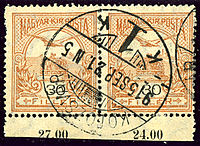


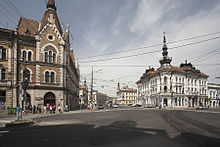
In the autumn of 1918, as World War I drew to a close, Cluj became a centre of revolutionary activity, headed by Amos Frâncu. On 28 October 1918, Frâncu made an appeal for the organisation of the "union of all Romanians".[57] Thirty-nine delegates were elected from Cluj to attend the proclamation of the union of Transylvania with the Kingdom of Romania in the Great National Assembly of Alba Iulia on 1 December 1918;[57] the transfer of sovereignty was formalized by the Treaty of Trianon in June 1920.[58] The interwar years saw the new authorities embark on a "Romanianisation" campaign: a Capitoline Wolf statue donated by Rome was set up in 1921; in 1932 a plaque written by historian Nicolae Iorga was placed on Matthias Corvinus's statue, emphasising his Romanian paternal ancestry; and construction of an imposing Orthodox cathedral began, in a city where only about a tenth of the inhabitants belonged to the Orthodox state church.[59] This endeavour had only mixed results: by 1939, Hungarians still dominated local economic (and to a certain extent) cultural life: for instance, Cluj had five Hungarian daily newspapers and just one in Romanian.[59]
In 1940, Cluj, along with the rest of
On 11 October 1944 the city was captured by
The Hungarian Revolution of 1956 produced a powerful echo within the city; there was a real possibility that demonstrations by students sympathizing with their peers across the border could escalate into an uprising.[67][68] The protests provided the Romanian authorities with a pretext to speed up the process of "unification" of the local Babeș (Romanian) and Bolyai (Hungarian) universities,[69] allegedly contemplated before the 1956 events.[70][71] Hungarians remained the majority of the city's population until the 1960s. Then Romanians began to outnumber Hungarians,[72] due to the population increase as a result of the government's forced industrialisation of the city and new jobs.[73] During the Communist period, the city recorded a high industrial development, as well as enforced construction expansion.[73] On 16 October 1974, when the city celebrated 1850 years since its first mention as Napoca, the Communist government changed the name of the city by adding "Napoca" to it.[27]
1989 revolution and after
During the
Geography



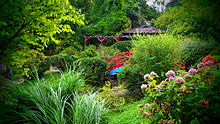
Cluj-Napoca, located in the central part of
Built on the banks of the river Someșul Mic, the city is also crossed over by brooks or streams such as Pârâul Țiganilor, Pârâul Popești, Pârâul Nădășel, Pârâul Chintenilor, Pârâul Becaș, Pârâul Murătorii; Canalul Morilor runs through the centre of town.[78]
A wide variety of flora grow in the Cluj-Napoca Botanical Garden; some animals have also found refuge there. The city has a number of other parks, of which the largest is the Central Park. This park was founded during the 19th century and includes an artificial lake with an island, as well as the largest casino in the city, Chios. Other notable parks in the city are the Iuliu Hațieganu Park of the Babeș-Bolyai University, which features some sport facilities, the Hașdeu Park, within the eponymous student housing district, the high-elevation Cetățuia, and the Opera Park, behind the building of the Cluj-Napoca Romanian Opera.
Surroundings


The city is surrounded by forests and grasslands. Rare species of plants, such as

A modern, 750-metre (820 yd)-long
There are a large number of castles in the countryside surroundings, constructed by wealthy medieval families living in the city. The most notable of them is the
Climate
Cluj-Napoca has a
The city has the best air quality in the European Union,[95] according to research published in 2014 by a French magazine and air-quality organization that studied the EU's hundred largest cities.[96]
| Climate data for Cluj-Napoca, 1991–2020 normals, extremes 1901–2020 | |||||||||||||
|---|---|---|---|---|---|---|---|---|---|---|---|---|---|
| Month | Jan | Feb | Mar | Apr | May | Jun | Jul | Aug | Sep | Oct | Nov | Dec | Year |
| Record high °C (°F) | 14.1 (57.4) |
19.6 (67.3) |
26.6 (79.9) |
30.2 (86.4) |
32.5 (90.5) |
36.0 (96.8) |
38.0 (100.4) |
38.5 (101.3) |
34.4 (93.9) |
32.6 (90.7) |
26.0 (78.8) |
18.7 (65.7) |
38.5 (101.3) |
| Mean daily maximum °C (°F) | 0.9 (33.6) |
4.1 (39.4) |
10.2 (50.4) |
16.6 (61.9) |
21.4 (70.5) |
24.9 (76.8) |
26.7 (80.1) |
27.0 (80.6) |
21.5 (70.7) |
15.6 (60.1) |
8.4 (47.1) |
1.9 (35.4) |
14.9 (58.8) |
| Daily mean °C (°F) | −2.5 (27.5) |
−0.4 (31.3) |
4.3 (39.7) |
10.1 (50.2) |
14.9 (58.8) |
18.5 (65.3) |
20.1 (68.2) |
19.8 (67.6) |
14.7 (58.5) |
9.4 (48.9) |
3.9 (39.0) |
−1.1 (30.0) |
9.3 (48.7) |
| Mean daily minimum °C (°F) | −5.2 (22.6) |
−3.8 (25.2) |
−0.1 (31.8) |
4.7 (40.5) |
9.1 (48.4) |
12.7 (54.9) |
14.2 (57.6) |
13.9 (57.0) |
9.6 (49.3) |
4.9 (40.8) |
0.6 (33.1) |
−3.6 (25.5) |
4.8 (40.6) |
| Record low °C (°F) | −34.2 (−29.6) |
−32.5 (−26.5) |
−22.0 (−7.6) |
−8.4 (16.9) |
−3.5 (25.7) |
0.4 (32.7) |
5.2 (41.4) |
0.5 (32.9) |
−8.8 (16.2) |
−16.8 (1.8) |
−22.3 (−8.1) |
−27.9 (−18.2) |
−34.2 (−29.6) |
| Average precipitation mm (inches) | 27.3 (1.07) |
24.8 (0.98) |
34.6 (1.36) |
51.0 (2.01) |
71.2 (2.80) |
91.0 (3.58) |
87.2 (3.43) |
64.7 (2.55) |
55.5 (2.19) |
45.3 (1.78) |
33.8 (1.33) |
34.0 (1.34) |
620.4 (24.43) |
| Average snowfall cm (inches) | 6.0 (2.4) |
11.5 (4.5) |
5.8 (2.3) |
1.3 (0.5) |
0.0 (0.0) |
0.0 (0.0) |
0.0 (0.0) |
0.0 (0.0) |
0.0 (0.0) |
0.5 (0.2) |
2.6 (1.0) |
5.8 (2.3) |
33.5 (13.2) |
| Average precipitation days (≥ 1.0 mm) | 6.7 | 6.8 | 7.0 | 8.5 | 10.1 | 10.6 | 10.0 | 7.1 | 7.6 | 7.0 | 6.5 | 6.9 | 94.8 |
| Average relative humidity (%)
|
87 | 82 | 74 | 72 | 74 | 77 | 76 | 76 | 78 | 81 | 86 | 88 | 79 |
| Average dew point °C (°F) | −4.3 (24.3) |
−4.7 (23.5) |
−0.3 (31.5) |
3.8 (38.8) |
9.1 (48.4) |
11.9 (53.4) |
12.8 (55.0) |
12.9 (55.2) |
10.2 (50.4) |
5.5 (41.9) |
0.6 (33.1) |
2.9 (37.2) |
5.0 (41.1) |
| Mean monthly sunshine hours | 70.2 | 100.9 | 159.2 | 188.7 | 230.1 | 253.1 | 265.7 | 260.7 | 190.2 | 153.5 | 89.4 | 54.6 | 2,016.3 |
| Mean daily daylight hours | 9 | 10.3 | 11.9 | 13.6 | 15.1 | 15.8 | 15.4 | 14.2 | 12.5 | 10.9 | 9.4 | 8.6 | 12.2 |
| Average ultraviolet index | 1 | 2 | 3 | 5 | 7 | 8 | 8 | 7 | 5 | 3 | 1 | 1 | 4 |
| Source 1: NOAA (snow and Dew Point 1961–1990)[97][98] Romanian National Statistic Institute,[99] | |||||||||||||
| Source 2: Deutscher Wetterdienst (humidity, 1973–1993)[100] Weather Atlas(Daylight-UV)[101] | |||||||||||||
Law and government
Administration

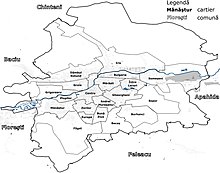
The city government is headed by a
| Party | Seats | Current Local Council[103] | ||||||||||||||||
|---|---|---|---|---|---|---|---|---|---|---|---|---|---|---|---|---|---|---|
| National Liberal Party (PNL) | 16 | |||||||||||||||||
| Save Romania Union (USR) | 5 | |||||||||||||||||
| Democratic Alliance of Hungarians (UDMR/RMDSZ) | 4 | |||||||||||||||||
| Social Democratic Party (PSD) | 2 | |||||||||||||||||
Because of the last years' massive urban development, in 2005 some areas of Cluj were named as districts (Sopor, Borhanci, Becaș, Făget, Zorilor South), but most of them are still construction sites.[104] Beside these, there are some other building areas like Tineretului, Lombului or Oser, which are likely to become districts in the following years.[105]
Additionally, as Cluj-Napoca is the capital of Cluj County, the city hosts the palace of the prefecture, the headquarters of the county council (consiliu județean) and the prefect, who is appointed by Romania's central government.[102] The prefect is not allowed to be a member of a political party, and his role is to represent the national government at the local level, acting as a liaison and facilitating the implementation of National Development Plans and governing programmes at the local level.[102] Like all other local councils in Romania, the Cluj-Napoca local council, the county council and the city's mayor are elected every four years by the population.[102]
Cluj-Napoca is also the capital of the historical region of
The executive presidium of the
Eleven hospitals function in the city, nine of which are run by the county and two (for oncology and cardiology) by the
Justice system
Cluj-Napoca has a complex judicial organisation, as a consequence of its status of county capital. The Cluj-Napoca Court of Justice is the local judicial institution and is under the purview of the Cluj County Tribunal, which also exerts its jurisdiction over the courts of Dej, Gherla, Turda, and Huedin.[113] Appeals from these tribunals' verdicts, and more serious cases, are directed to the Cluj Court of Appeals. The city also hosts the county's commercial and military tribunals.[113]
Cluj-Napoca has its own municipal police force, Poliția Municipiului Cluj-Napoca, which is responsible for policing of crime within the whole city, and operates a number of special divisions. The Cluj-Napoca Police are headquartered on Decebal Street in the city centre (with a number of precincts throughout the city) and it is subordinated to the County's Police Inspectorate on Traian Street.[114] City Hall has its own community police force, Poliția Primăriei, dealing with local community issues. Cluj-Napoca also houses the County's Gendarmerie Inspectorate.
Crime

Cluj-Napoca and the surrounding area (
Also notorious was the case of serial killer
A 2006 poll shows a high degree of satisfaction with the work of the local police department. More than half the people surveyed during a 2005–2006 poll declared themselves satisfied (62.3%) or very satisfied (3.3%) with the activity of the county police department.[120] The study found the highest satisfaction with car traffic supervision, the presence of officers in the street, and road education; on the negative side, corruption and public transport safety remain concerns.
Efforts made by local authorities in the Cluj-Napoca district at the end of the 1990s to reform the protection of children's rights and assistance for street children proved insufficient due to lack of funding, incoherent policies and the absence of any real collaboration between the actors involved (Child Rights Protection Directorate, Social Assistance Service within the District Directorate for Labour and Social Protection, Minors Receiving Centre, Guardian Authority within the City Hall, Police). There are numerous street children, whose poverty and lack of documented identity brings them into constant conflict with local law enforcement.[121]
Following cooperation between the local governmental council and the
From 2000 onwards, Cluj-Napoca has seen an increase in illegal
Demographics
| Historical population of Cluj-Napoca | |||||||||||||
| Year | Population | %± | Romanians | Hungarians | |||||||||
|---|---|---|---|---|---|---|---|---|---|---|---|---|---|
| 1453 est. | 6,000[125] | — | — | — | |||||||||
| 1703 | 7,500[126] | 25% | — | — | |||||||||
| 1714 | 5,000[127] | −33.3% | — | — | |||||||||
| 1770 | 10,500[128] | 110% | — | — | |||||||||
| 1785 | 9,703[126][129] | −7.6% | — | — | |||||||||
| 1787 | 10,476[126][129] | 7.9% | — | — | |||||||||
| 1835 | 14,000[126][130] | 33.6% | — | — | |||||||||
| 1850 | 19,612 | 40% | 21.0% | 62.8% | |||||||||
| 1880 | 32,831 | 67.4% | 17.1% | 72.1% | |||||||||
| 1890 | 37,184 | 13.2% | 15.2% | 79.1% | |||||||||
| 1900 | 50,908 | 36.9% | 14.1% | 81.1% | |||||||||
| 1910 census[b] | 62,733 | 23.2% | 14.2% | 81.6% | |||||||||
| 1920 | 85,509 | 36.3% | 34.7% | 49.3% | |||||||||
| 1930 census | 100,844[131] | 17.9% | 34.6% | 47.3% | |||||||||
| 1941[c][d] | 114,984 | 14% | 9.8% | 85.7% | |||||||||
| 1948 census | 117,915 | 2.5% | 40% | 57% | |||||||||
| 1956 census[e] | 154,723 | 31.2% | 47.8% | 47.9% | |||||||||
| 1966 census | 185,663 | 20% | 56.5% | 41.4% | |||||||||
| 1977 census | 262,858 | 41.5% | 65.8% | 32.8% | |||||||||
| 1992 census | 328,602 | 25% | 76.6% | 22.7% | |||||||||
| 2002 census | 317,953[132] | −3.2% | 79.4% | 19.0% | |||||||||
| 2011 census[f] | 324,576[133][4][134] | 2.1% | 81.5% | 16.4% | |||||||||
| 2021 census | 286,598[135] | −11.7% | 84.6% | 13.9% | |||||||||
|
Source (if not otherwise specified): | |||||||||||||
The city's population, at the
Ethnic composition of Cluj-Napoca (2021)
Religious composition of Cluj-Napoca (2021)
In the modern era, Cluj's population experienced two phases of rapid growth, the first in the late 19th century, when the city grew in importance and size, and the second during the
From the Middle Ages onwards, the city of Cluj has been a multicultural city with a diverse cultural and religious life. In 1930, the city was 26.7% Reformed, 22.6% Greek Catholic, 20.1% Roman Catholic, 13.4% Jewish, 11.8% Orthodox, 2.4% Lutheran and 2.1% Unitarian.[138] Contributing factors for demographic shifts were the extermination[139] and emigration[140] of the city's Jews, the outlawing of the Greek-Catholic Church (1948–89)[141] and the gradual decline in the Hungarian population.
On a more historical note, the Jewish community has figured centrally in the history of Transylvania, and in that of the wider region.
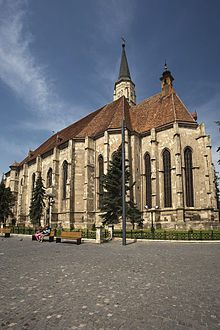
In the 14th century, most of the town's inhabitants and the local elite were Saxons,[42] largely descended from settlers brought in by the Kings of Hungary in the twelfth and thirteenth centuries[144] to develop and defend the southern borders of the province.[144] By the middle of the next century roughly half the population had Hungarian names. In Transylvania as a whole, the Reformation sharpened ethnic divisions: Saxons became Lutheran while Hungarians either remained Catholic or became Calvinist or Unitarian. In Kolozsvár, however, the religious lines were blurred. Isolated both geographically from the main areas of German settlement in southern Transylvania[142] and institutionally because of their distinctive religious trajectory, many Saxons eventually assimilated to the Hungarian majority over several generations. New settlers to the town largely spoke Hungarian, a language that many Saxons gradually adopted.[42] (In the seventeenth century, out of more than thirty royal free towns, only seven had a Hungarian majority, with Kolozsvár/Klausenburg being one of them;[145] the rest were largely German-dominated.[145]) In this manner Kolozsvár became largely Hungarian speaking and would remain so through the mid-20th century, though 4.8% of its residents identified as German as late as 1880.[146]
The Roma form a sizable minority in contemporary Romania, and a small but visible presence in Cluj-Napoca: self-identifying Roma in the city comprise only 1 percent of the population; yet they are a familiar presence in and around the central market, selling flowers, used clothes, and tinware.[142] They are an important object of public discourse and media representation at the national level; however, Cluj-Napoca, with its small Roma population, has not been a major focus of Roma ethno-political activity.[142]
Hungarian community
Almost 50,000 Hungarians live in Cluj-Napoca. The city is home to the second-largest urban Hungarian community in Romania, after Târgu Mureș,[134] with an active cultural and academic life: the city features a Hungarian state theatre and opera, as well as Hungarian research institutions, such as Erdélyi Múzeumi Egyesület (EME), Erdélyi Magyar Műszaki Tudományos Társaság and Bolyai Társaság.[147] With respect to religious affairs, the city houses central offices for the Reformed Diocese of Transylvania, the Unitarian Diocese and an Evangelical Lutheran Church Diocese (all of which train their clergy at the Protestant Theological Institute of Cluj). Several newspapers and magazines are published in the Hungarian language, yet the community also receives public and private television and radio broadcasts (see Culture and media). As of 2007[update], 7,000 students attended courses in the 55 Hungarian-language specialisations at the Babeș-Bolyai University.[148] Gheorghe Funar, mayor of Cluj-Napoca from 1992 to 2004, was notorious for acts of ethnic provocation, bedecking the city's streets in the colours of the Romanian flag and arranging pickets outside the city's Hungarian consulate; however, tensions have subsided since.[11] Since 2010, the Hungarian Cultural Days of Cluj festival takes place each summer.[149]
Economy


Cluj-Napoca is an important economic centre in Romania. Local brands that have become well known at a national, and to some extent even international level, include:
The American online magazine
Cluj-Napoca is also an important regional commercial centre, with many street
Among the retailers found in the city's shopping centers are H&M, Zara, Guess, Camaïeu, Bigotti, Orsay, Jolidon, Kenvelo, Triumph, Tommy Hilfiger, Sephora, Yves Rocher, Swarovski, Ecco, Bata, Adidas, Converse, and Nike.[171]
In 2021, the city's general budget was 2.117 billion lei, the equivalent of over 433 million Euros.[172] This marks a 114% increase over the 2008 level of 990 million lei[173] or 266 million Euros.
Tourism
In 2007, the hotel industry in the county of Cluj offered total accommodations of 6,472 beds, of which 3,677 were in hotels, 1,294 in guesthouses and the rest in chalets, campgrounds, or hostels.[174] A total of 700,000 visitors, 140,000 of whom were foreigners, stayed overnight.[174] However, a considerable share of visits is made by those who visit Cluj-Napoca for a single day, and their exact number is not known. The largest numbers of foreign visitors come from Hungary, Italy, Germany, the United States, France, and Austria.[174] Moreover, the city's 140 or so travel agencies help organise domestic and foreign trips; car rentals are also available.[175]
Arts and culture
Cluj-Napoca has a diverse and growing cultural scene, with cultural life exhibited in a number of fields, including the
Landmarks

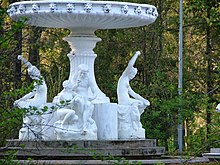
Cluj-Napoca has a number of landmark buildings and monuments. One of those is the
In front of the church is the
Another landmark of Cluj-Napoca is the Palace of Justice, built between 1898 and 1902, and designed by architect Gyula Wagner in an eclectic style.[187] This building is part of an ensemble erected in Avram Iancu Square that also includes the National Theatre, the Palace of Căile Ferate Române, the Palace of the Prefecture, the Palace of Finance and the Palace of the Orthodox Metropolis. An important eclectic ensemble is Iuliu Maniu Street, featuring symmetrical buildings on either side, after the urbanistic trend of Georges-Eugène Haussmann.[188] A highlight of the city is the botanical garden, situated in the vicinity of the centre. Beside this garden, Cluj-Napoca is also home to some large parks, the most notable being the Central Park with the Chios Casino and a large statuary ensemble. Many of the city's notable figures are buried in Hajongard Cemetery, which covers 14 hectares (35 acres).[citation needed]
As an important cultural centre, Cluj-Napoca has many theatres and museums. The latter include the National Museum of Transylvanian History, the Ethnographic Museum, the Cluj-Napoca Art Museum, the Pharmacy Museum, the Water Museum and the museums of Babeș-Bolyai University—the University Museum, the Museum of Mineralogy, the Museum of Paleontology and Stratigraphy, the Museum of Speleology, the Botanical Museum and the Zoological Museum.
Visual arts
In terms of visual arts, the city contains a number of galleries featuring both classical and contemporary Romanian art, as well as selected international works.
The
The most notable of the city's other galleries is the Gallery of the Union of Plastic Artists. Situated in the city centre, this gallery presents collections drawn from the contemporary arts scene. The Gallery of Folk Art includes traditional Romanian interior decoration artworks.
Historically, the city was one of the most important cultural and artistic centres in 16th-century Transylvania. The Renaissance workshop, formed in 1530 and strongly supported by the Transylvanian princes, served local and wider requirements: from the middle of the century onwards, when the Ottomans had conquered central Hungary, it extended its activity throughout the new principality. Its style, the "Flower Renaissance", used a variety of plant ornament enriched with coats of arms, figures and inscriptions. It continued to be of great importance into the 18th century, and traces of it are still apparent in 20th-century vernacular art; Klausenburg was central to the long, anachronistic survival of the style, particularly among Hungarians.[194]
Performing arts
The city has a number of renowned facilities and institutions involving
Music and nightlife
Cluj-Napoca is the residence of some well-known Romanian musicians. Examples of homegrown bands include the Romanian alternative rock band
The city also includes
, a Turkish-influenced type of music.Traditional culture
In spite of the influences of modern culture, traditional Romanian culture continues to influence various domains of art.

Cluj-Napoca hosts an ethnographic museum, the Ethnographic Museum of Transylvania, which features a large indoor collection of traditional cultural objects, as well as an open-air park, the oldest of this kind in Romania, dating back to 1929.[206][207]
The National Museum of Transylvanian History is another important museum in Cluj-Napoca, containing a collection of artefacts detailing Romanian history and culture from prehistoric times, the Dacian era, medieval times and the modern era.[208] Moreover, the city also preserves a Historic Collection of the Pharmacy, in the building of its first pharmacy (16th century), the Hintz House.[208]
Cultural events and festivals
Cluj-Napoca hosts a number of cultural festivals of various types. These occur throughout the year, though are more frequent in the summer months. "Sărbătoarea Muzicii" (Fête de la Musique) is a music festival taking place yearly on 21 June in a number of Romanian cities, Cluj-Napoca included, organised under the aegis of the French Cultural Centre.[209] Additionally, Splaiul Independenței, on the banks of Someșul Mic, hosts a number of beer festivals throughout the summer, among them the "Septemberfest", modelled after the German Oktoberfest.[210] In 2015, the city will be the European Youth Capital, an event with a budget of 5.7 million euros that is projected to boost tourism by about a fifth.[211]
The city has seen a number of important music events, including the

The
Also held in the city is Delahoya, Romania's oldest
Architecture
Cluj-Napoca's salient architecture is primarily Renaissance, Baroque and Gothic. The modern era has also produced a remarkable set of buildings from the mid-century style. The mostly utilitarian Communist-era architecture is also present, although only to a certain extent, as Cluj-Napoca never faced a large systematisation programme. Of late, the city has seen significant growth in contemporary structures such as skyscrapers and office buildings, mainly constructed after 2000.[230]
Historical architecture
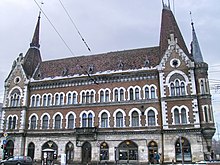
The nucleus of the old city, an important cultural and commercial centre, used to be a military camp, attested in documents with the name "castrum Clus".
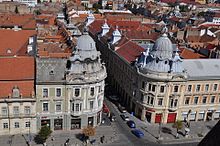
The oldest residence in Cluj-Napoca is the
As Renaissance styles survived late in the city, the appearance of Baroque art was also delayed, but from the mid-18th century Klausenburg was once again at the centre of the development and spread of art in Transylvania, as it had been two centuries earlier. The first enthusiasts for Baroque were the Catholic Church and the landed aristocracy. Artists came initially from south Germany and Austria, but by the end of the century most of the work was by local craftsmen. The earliest signs of the new style appear in the furnishings of St. Michael's church: the altarpieces and pulpit, which date to the 1740s, are carved, painted and richly decorated with figures. An altarpiece depicting the
Both
The banks of the Someșul Mic also feature a wide variety of such old buildings. The end of the 19th century brought a building ensemble that fastens the corners of the oldest bridge over the river, at the north end of the Regele Ferdinand Avenue. The Berde, Babos, Elian, Urania, and Széki palaces consist of a mixture of Baroque, Renaissance and Gothic styles, following the Art Nouveau/Secession and Revival specifics.[233]

In the 2000s, the old city centre underwent extensive restoration works, meant to convert much of it into a pedestrian area, including
Modern and Communist architecture

Part of Cluj-Napoca's architecture is made up of buildings constructed during the
Still, the centre hosts some examples of modern architecture dating back to the Communist era. The Hungarian Theatre building was erected at the beginning of the 20th century, but underwent an avant-garde renovation in 1961, when it acquired a
Some outer districts, especially Mănăștur, and to a certain extent Gheorgheni and Grigorescu, consist mainly of such large apartment ensembles.[230]
Contemporary architecture

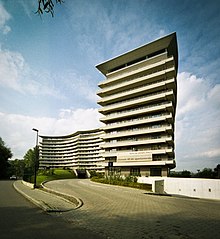
Since 1989, modern skyscrapers and glass-fronted buildings have altered the skyline of Cluj-Napoca. Buildings from this time are mostly made out of glass and steel, and are usually high-rise. Examples include shopping malls (particularly the
Another
The headquarters of
Cluj-Napoca is undergoing a period of architectural revitalisation that is set to bring the manner of expansion to the vertical. A financial centre, containing a tower of 15 storeys, is slated for completion in 2010 on Ploiești Street.[239] Two 35-storey twin towers are projected to be constructed in the Sigma area in Zorilor,[240][241] while the Florești area will host a complex of three towers with 32 levels each.[242] As of February 2020, the aforementioned projects were never completed or were postponed indefinitely.
Transport
Cluj-Napoca has a complex system of regional transportation, providing road, air and rail connections to major cities in Romania and Europe. It also features a public transportation system consisting of bus, trolleybus and tram lines.
Road
Cluj-Napoca is an important node in the
The number of automobiles licensed in Cluj-Napoca is estimated at 175,000.[246] As of 2007[update], Cluj County ranks sixth nationwide according to the cars sold during that year, with 12,679 units, corresponding to a four percent share. One tenth of these cars were limousines or SUVs.[247] Some 3,300 taxis are also licensed to operate in Cluj-Napoca.[248]
Air
The
Rail
Cluj-Napoca Rail Station, located about 2 kilometres (1.2 mi) north of the city centre, is situated on the CFR-Romanian Railways Main Line 300 (Bucharest – Oradea – Romanian Western Border) and on Line 401 (Cluj-Napoca – Dej). CFR provides direct rail connections to all the major Romanian cities and to Budapest. The rail station is very well connected to all parts of the city by the trams, trolleybuses and buses of the local public transport company, CTP.
The city is also served by two other secondary rail stations, the Little Station (Gara Mică), which is technically part of and situated immediately near the main station, and Cluj-Napoca East (Est). There is also a cargo station, Halta "Clujana".
Public transport
CTP, the local public transport company, runs an extensive 321 kilometres (199 mi) public transport network within the city using 3 tram lines, 6 trolleybus lines and 21 bus routes.[79] Transport in the Cluj-Napoca metropolitan area is also covered by a number of private bus companies, such as Fany and MV Trans 2007, providing connections to neighboring towns and villages.[253]
Trams
The local transportation company, CTP, manages a tram line that runs through the city. Planned modernisation will involve the installation of new rail tracks and the separation of the tram route from road traffic. This will bring a number of advantages, including vibration and shock reduction, a substantial noise decrease, long use expectancy and higher
Metro
In late 2018, studies began for a proposed
Culture and media
Cluj-Napoca is an important centre for


Apart from the regional editions, which are distributed throughout Transylvania, the national newspaper Ziua also runs a local franchise, Ziua de Cluj, that acts as a local daily, available only within city limits. Cluj-Napoca also boasts other newspapers of local interest, like Făclia and Monitorul de Cluj, as well as two free dailies, Informația Cluj and Cluj Expres. Clujeanul, the first of a series of local weeklies edited by the media trust CME, is one of the largest newspapers in Transylvania, with an audience of 53,000 readers per edition.[262] This weekly has a daily online version, entitled Clujeanul, ediție online, updated on a real-time basis. Cluj-Napoca is also the centre of the Romanian Hungarian language press. The city hosts the editorial offices of the two largest newspapers of this kind, Krónika and Szabadság,[263] as well as those of the magazines Erdélyi Napló and Korunk. Săptămâna Clujeană is an economic weekly published in the city, that also issues two magazines on successful local people and companies (Oameni de Succes and Companii de Succes) every year, while Piața A-Z is a newspaper for announcements and advertisements distributed throughout Transylvania. Cluj had an active press in the interwar period as well: publications included the Zionist newspaper Új Kelet, the official party organs Keleti Újság (for the Magyar Party) and Patria (for the National Peasants' Party);[264] and the nationalist Conștiința Românească and Țara Noastră, the latter a magazine directed by Octavian Goga.[265] Under Communism, publications included the socio-political and literary magazines Tribuna, Steaua, Utunk, Korunk, Napsugár and Előre as well as the regional Communist party daily organs Făclia and Igazság and the trilingual student magazine Echinox.[266][267]
Among the local television stations in the city, TVR Cluj (public) and One TV (private) broadcast regionally, while the others are restricted to the metropolitan area. Napoca Cable Network is available through cable, and broadcasts local content throughout the day. Other stations work as affiliates of national TV stations, only providing the audience with local reports in addition to the national programming. This situation is mirrored in the radio broadcasting companies: except for Radio Cluj, Radio Impuls and the Hungarian-language Paprika Rádió, all other stations are local affiliates of the national broadcasters. Casa Radio, situated on Donath Street, is one of the modern landmarks of the media and communications industry; it is, however, not the only one: Palatul Telefoanelor ("the telephone palace") is also a major modernist symbol of communications in the city centre.[citation needed]
Magazines published in Cluj-Napoca include HR Journal, a publication discussing human resources issues, J'Adore, a local shopping magazine that is also franchised in Bucharest, Maximum Rock Magazine, dealing with the rock music industry, RDV, a national hunting publication and Cluj-Napoca WWW, an English-language magazine designed for tourists. Cultural and social events as well as all other entertainment sources are the leading subjects of such magazines as Șapte Seri and CJ24FUN.
In the early 20th century, film production in Kolozsvár, led by Jenő Janovics, was the chief alternative to Budapest.[179] The first film made in the city, in association with the Parisian producer Pathé, was Sárga csikó ("Yellow Foal", 1912), based on a popular "peasant drama". Yellow Foal became the first worldwide Hungarian success, distributed abroad under the title The Secret of the Blind Man: 137 prints were sold internationally and the movie was even screened in Japan.[179]
The first artistically prestigious film in the annals of Hungarian cinematography was also produced on this site, based on a national classic, Bánk bán (1914), a tragedy written by József Katona.[179]
Later, the city was the production site of the 1991 Romanian drama Undeva în Est ("Somewhere in the East"),[268] and the 1995 Hungarian language film A Részleg ("Outpost").[269] Moreover, the Romanian-language film Cartier ("Neighbourhood", 2001) and its sequel Înapoi în cartier ("Back to the Neighbourhood", 2006) both feature a story replete with violence and rude language, behind the blocks in the city's Mănăștur district.[270] This district is also mentioned in the lyrics to the song Înapoi în cartier by La Familia member Puya, featured on the soundtrack of the motion picture.
Documentary and mockumentary productions set in the city include Irshad Ashraf's St. Richard of Austin, a tribute to the American film director Richard Linklater,[271] and Cluj-Napocolonia, a mockumentary imagining a fabulous city of the future.[272]
Education
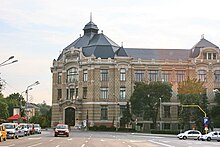
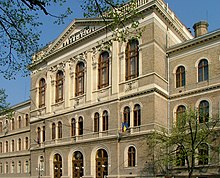
Higher education has a long tradition in Cluj-Napoca. The
The first mention of public education provided in the city dates back to 1409, namely the caption "Caspar notarius et rector scholarum" ("Caspar secretary and director of schools").
Sports

Football in the city features four clubs playing in the leagues organised by the Romanian Football Federation, in Liga 1—formerly Divizia A[278][279]—the top division in the Romanian football association, liga II and liga III.
The
The city is also represented in the
FCU Olimpia Cluj is the local women's soccer team, established in 2010 by Babeș-Bolyai University. The team won the Liga I 10 times, and Romanian Cup 6 times.

"Universitatea" club also incorporates teams in sports such as
In the automotive field, Cluj-Napoca hosts two stages in the National Rally Championship. Raliul Clujului is held in June;[285] the Avram Iancu Rally, held in September, has been officially organised since 1975, though there were several years when it was not held.[286] The latter rally begins in Cipariu Square and runs across the surroundings of the city.[287]
Amateur athletes are also active in Cluj-Napoca, with swimming pools,
Twin towns – sister cities
Cluj-Napoca is twinned with:[291]
 Dijon, France (1965)
Dijon, France (1965) Nantes, France (1990)
Nantes, France (1990) Zagreb, Croatia (1976)
Zagreb, Croatia (1976) Cologne, Germany (1976)
Cologne, Germany (1976) Pécs, Hungary (1990)
Pécs, Hungary (1990) Beersheba, Israel (1991)
Beersheba, Israel (1991) Columbia, United States (1991)
Columbia, United States (1991) Zhengzhou, China (1994)
Zhengzhou, China (1994) Makati, Philippines (1996)
Makati, Philippines (1996) Suwon, South Korea (1999)
Suwon, South Korea (1999) Chacao (Caracas), Venezuela (1999)
Chacao (Caracas), Venezuela (1999) São Paulo, Brazil (2000)
São Paulo, Brazil (2000) Korçë, Albania (2001)
Korçë, Albania (2001) Province of Parma, Italy (2005)
Province of Parma, Italy (2005) Rockford, United States (2005)
Rockford, United States (2005) East Lansing, United States (2005)
East Lansing, United States (2005) Rotherham, England, United Kingdom (2006)
Rotherham, England, United Kingdom (2006) Viterbo, Italy (2009)
Viterbo, Italy (2009)- Namur, Belgium (2010)
 Ningbo, China (2014)
Ningbo, China (2014) Ungheni, Moldova (2016)
Ungheni, Moldova (2016) Karaganda, Kazakhstan (2017)
Karaganda, Kazakhstan (2017) Braga, Portugal (2018)
Braga, Portugal (2018) Eskişehir, Turkey (2020)
Eskişehir, Turkey (2020)
Footnotes
a.^ The engraving, dating back to 1617, was executed by Georg Houfnagel after the painting of Egidius van der Rye (the original was done in the workshop of Braun and Hagenberg).
b.^ After the declaration of the union between the 1918–1920 period an exodus of Hungarian inhabitants occurred. Also, the city grew and many people moved in from the surrounding area and Cluj County as a whole, populated largely by Romanians.
c.^ In August 1940, as the second Vienna Award transferred the northern half of Transylvania to Hungary, many Hungarians and Romanians chose to leave or were exiled. After some ethnic Hungarians groups considered unreliable or insecure were sacked/expelled from Southern-Transylvania, the Hungarian officials also regularly expelled some Romanian groups from Northern-Transylvania.[292]
d.^ The 1941 Hungarian census is considered unreliable by most historians. In 1941, Cluj had 16,763 Jews. They were forced into ghettos in 1944 by the Hungarian authorities and deported to Auschwitz in May–June 1944.
e.^ In the 1960s a determined policy of industrialisation was initiated. Many people from the surrounding rural areas (largely Romanian) moved into the city, giving Cluj a Romanian majority.
f.^ Data refer to those for whom ethnicity is available, and do not include the 23,165 individuals (7.1% of the city's population) for whom such data are unavailable.
See also
Notes
- ^ a b "Portretul unui oraș" (in Romanian). Clujeanul. 21 September 2007. Archived from the original on 24 August 2010. Retrieved 9 October 2008.
- ^ a b "A kincses város" (in Hungarian). UFI. December 2004. Archived from the original on 2 September 2008. Retrieved 9 October 2008.
- ^ "Results of the 2020 local elections". Central Electoral Bureau. Archived from the original on 9 October 2020. Retrieved 11 June 2021.
- ^ a b c d e f g "Rezultate definitive ale Recensământului Populației și Locuințelor – 2011 – analiza". Cluj County Regional Statistics Directorate. 5 July 2013. Archived from the original on 4 May 2014. Retrieved 5 July 2013.
- ^ a b c d "Populaţia rezidentă după grupa de vârstă, pe județe și municipii, orașe, comune, la 1 decembrie 2021" (in Romanian). INSSE. 31 May 2023.
- ^ a b "Zona Metropolitana Urbana" (in Romanian). CJ Cluj. Archived from the original on 31 May 2009. Retrieved 25 May 2009.
- ^ a b c "Zona Metropolitană Urbană și Strategii de Dezvoltare a Zonei Metropolitane Cluj-Napoca" (in Romanian). Cluj County Council. Archived from the original on 14 November 2007. Retrieved 12 March 2008.
- ^ a b c "Asociația Metropolitană e "la cheie". Mai trebuie banii" (in Romanian). Ziua de Cluj. 9 January 2009. Archived from the original on 9 December 2012. Retrieved 11 February 2009.
- ^ a b c d "Wanted: clujeanul verde" (in Romanian). Foaia Transilvană. 6 March 2008. Archived from the original on 11 May 2008. Retrieved 12 May 2008.
- ^ "Catedrala "Sf. Mihail"" (in Romanian). Clujonline.com. Archived from the original on 22 March 2008. Retrieved 12 March 2008.
- ^ a b c d "Cluj: Buzz grips university town". Financial Times. 6 March 2008. Archived from the original on 10 December 2022. Retrieved 13 March 2008.
- ^ "Five alive – New regions – Five territories to watch". Monocle. Vol. 1, no. 9. December 2007. Archived from the original on 5 March 2008. Retrieved 12 March 2008.
- ^ Alexandra Groza (8 January 2008). "Presa britanică: "Clujul, campion mondial la dezvoltare"" (in Romanian). Clujeanul. Archived from the original on 4 May 2008. Retrieved 12 March 2008.
- ^ "cluj2015.eu". www.cluj2015.eu. Archived from the original on 17 December 2014. Retrieved 14 December 2014.
- ^ Raluca Sas (6 December 2017). "Cluj-Napoca a câștigat titlul de "Oraș European al Sportului 2018"". monitorulcj.ro (in Romanian). Archived from the original on 23 April 2018. Retrieved 22 April 2018.
- ^ "Cluj-Napoca". Retrieved 8 April 2024.
- ^ Lukács 2005, p.14
- ^ a b "O istorie inedită a Clujului – Cetatea coloniștilor sași" (in Romanian). ClujNet.com. Archived from the original on 30 January 2008. Retrieved 16 March 2008.
- ^ a b c d e f g h Lazarovici et al. 1997, p.32 (3.1 De la Napoca romană la Clujul medieval)
- ^ a b Gaal, György (19 July 2000). "Kolozsvári kronológia – Kolozsvár kétezer esztendeje dátumokban" (in Hungarian). Szabadság. Archived from the original on 7 December 2008. Retrieved 15 March 2008.
- ^ a b Asztalos, Lajos (4 August 2003). "Kolozsvár neve" (in Hungarian). Szabadság. Archived from the original on 7 December 2008. Retrieved 15 March 2008.
- ^ a b Szabó, Attila m. "Dicționar de localități din Transilvania" (in Romanian). Archived from the original on 22 August 2010. Retrieved 15 March 2008.
- ^ Le Vie d'Italia, vol. 46/1940, issues 7-12, p. 1172
- ISBN 978-994-434478-4
- ISBN 9781571816412. Retrieved 14 October 2021.
- ISBN 0-8476-8467-9. Retrieved 15 October 2021.
- ^ a b "Cluj-Napoca. Istoric" (in Romanian). Clujonline.com. Archived from the original on 19 February 2020. Retrieved 14 March 2008.
- ^ Brubaker et al. 2006, p.xxi
- ^ Lazarovici et al. 1997, p.39 (3.1 De la Napoca romană la Clujul medieval)
- ^ Bunta, Magda (1970), "A kolozsvári ötvöscég középkori pecsétje" (PDF), Folia Archaeologica (in Hungarian): 151–154, archived (PDF) from the original on 16 October 2014
- ^ Bunbury 1879, p. 516.
- ^ a b Lazarovici et al. 1997, pp. 202–03 (6.2 Cluj in the Old and Ancient Epochs)
- ^ Lazarovici et al. 1997, p. 17 (2.7 Napoca romană)
- ^ Brubaker et al. 2006, p.89
- ^ Alicu 2003, p.9
- ISBN 973-577-249-3.
- ^ a b Lazarovici et al. 1997, p. 204 (6.3 Medieval Cluj)
- PMID 31511583.
- ^ "Buried Couple Found Holding Hands - Archaeology Magazine". www.archaeology.org. Archived from the original on 4 April 2020. Retrieved 28 November 2019.
- ^ Brubaker et al. 2006, pp.89–90
- ^ a b c Lazarovici et al. 1997, p.38 (3.1 De la Napoca romană la Clujul medieval)
- ^ a b c d Brubaker et al. 2006, pp. 90–1
- ^ a b c d e Lazarovici et al. 1997, p. 205 (6.3 Medieval Cluj)
- ^ Martâniuc, Cristina. "Probleme actuale ale calității de subiect de drept internațional public contemporan" (PDF) (in Romanian). CNAA (Republic of Moldova). Archived from the original (PDF) on 8 January 2007. Retrieved 17 March 2008.
În istoria poporului român, o uniune personală a fost creată în anul 1600 prin unirea politică a celor trei țări Românești – Transilvania, Moldova și Țara Românească – sub un singur domnitor: Mihai Vodă Viteazul (In the history of the Romanian people, a personal union was created in 1600 with the political union of the three Romanian countries – Transylvania, Moldova and Wallachia – under a single ruler: Michael the Brave)
- ^ Ciorănescu, George (1 September 1976). Michael the Brave – Evaluations and Revaluations of the Walachian Prince (PDF). Radio Free Europe Research: RAD Background Report/191. Archived from the original (PDF) on 8 April 2008. Retrieved 15 March 2008.
- ^ "Treaty of Carlowitz". Encyclopædia Britannica. 2008. Archived from the original on 19 June 2008. Retrieved 14 March 2008.
- ^ a b Brubaker et al. 2006, p.91
- ^ Lazarovici et al. 1997, pp.42,44,68 (3.1 De la Napoca romană la Clujul medieval; 4.1 Centru al mișcării naționale)
- ^ a b Lazarovici et al. 1997, p.206 (6.4 Cluj in Modern Times)
- ^ von Wurzbach, Constantin (1884). Urban, Karl Freiherr. In: Biographisches Lexikon des Kaiserthums Oesterreich (Biographical Encyclopedia of the Austrian Empire) (in German). Vol. 49. Vienna: Kaiserlich-königliche Hof- und Staatsdruckerei. p. 118.
- ^ "Bem's Campaign in Transylvania; Revolutionary Consolidation and Its Contradictions". MEK (Hungarian Electronic Library). Archived from the original on 10 January 2009. Retrieved 14 March 2008.
- ^ Brubaker et al. 2006, p.92
- ^ a b Lazarovici et al. 1997, pp.74–5 (6.4 Centru al mișcării naționale)
- ^ a b "Relația dintre elite și popor în perioada memorandistă" (PDF) (in Romanian). Cluj: Centrul de Resurse pentru Diversitate Etnoculturală. Archived (PDF) from the original on 8 April 2008. Retrieved 15 March 2008.
- ^ Ambrus Miskolczy (2001). "A modern román nemzet a "régi" Magyarországon" (PDF) (in Hungarian). Rubicon. Archived (PDF) from the original on 20 July 2011. Retrieved 29 July 2010.
- ISBN 978-0-88033-154-8.
- ^ a b Lazarovici et al. 1997, p. 207 (6.4 Cluj in Modern Times)
- ^ Brubaker et al. 2006, p.68
- ^ a b Brubaker et al. 2006, pp. 100–1
- ISBN 0-312-12116-4.
- ^ a b c d e Lazarovici et al. 1997, pp. 140–41 (5.2 Dictatul de la Viena – 30 August 1940)
- ^ Sulzberger, C.L. (12 July 1940). "Hungarians' Army Marches into Cluj; Receives a Frenzied Welcome from Magyars in Former Rumanian Territory, but Atmosphere is Tense; Officers of Occupying Troops Charge that 12 Were Slain by Retreating Force". The New York Times. Archived from the original on 3 July 2018. Retrieved 15 March 2008.
- ISBN 0-521-85766-X. Archivedfrom the original on 21 August 2010. Retrieved 22 March 2008.
- ISBN 0-465-02153-0.
- ^ "Russians Smash on; Memel Reported Cut Off as New Drive Reaches German Frontier; Szeged, Cluj Seized; Soviet Tanks Cross Tisza, Menacing Budapest; Berlin Admits Russians Smash on Near East Prussia". The New York Times. 12 October 1944. Archived from the original on 3 July 2018. Retrieved 15 March 2008.
- ^ Lazarovici et al. 1997, p. 213 (6.5 Cluj in Modern Times)
- ^ Lazarovici et al. 1997, p. 153 (5.3 Perioada totalitarismului)
- ^ Johanna Granville, "If Hope is Sin, Then We Are All Guilty: Romanian Students' Reactions to the Hungarian Revolution and Soviet Intervention, 1956–1958 Archived 18 September 2012 at the Wayback Machine", Carl Beck Paper, no. 1905 (April 2008): 1–78.
- .
- ^ Kálmán, Aniszi (March 1999). A Bolyai Tudományegyetem utolsó esztendeje: Beszélgetés dr. Sebestyén Kálmánnal. Hitel, XII, No. 3. p. 83.
- ^ A romániai magyar fõiskolai oktatás: Múlt, jelen, jövõ. Cluj/Kolozsvár: Jelenlét Alkotó Társaság. 1990. p. 21.
- ^ a b Varga, E. Árpád. "Erdély etnikai és felekezeti statisztikája (1850–1992)" [Ethnic and denominational statistics of Transylvania (1850–1992)] (in Hungarian). Archived from the original on 28 January 2022. Retrieved 16 March 2008.
- ^ a b c Lazarovici et al. 1997, pp. 154,159 (5.3 Perioada totalitarismului)
- ^ "O mură în gura comisiei "Evenimentele din decembrie"" (in Romanian). Academia Cațavencu. 30 January 1996. Archived from the original on 12 May 2021. Retrieved 21 March 2008.
- ^ "Guvernul Boc a fost învestit de Parlament". Cotidianul (in Romanian). 22 December 2008. Archived from the original on 11 January 2009. Retrieved 22 July 2009.
- ^ a b Bianca Preda (22 June 2012). "Emil Boc a depus jurământul de primar". Adevărul (in Romanian). Archived from the original on 26 June 2012. Retrieved 22 June 2012.
- ^ "Geografia județului Cluj" (in Romanian). INSSE – Direcția Regională de Statistică Cluj. Archived from the original on 29 November 2007. Retrieved 15 March 2008.
- ^ a b c Lukács 2005, pp.9–11
- ^ a b c d e "Amenajarea teritoriului, urbanism, infrastructură" [Spatial planning, urbanism, infrastructure] (PDF) (in Romanian). Cluj-Napoca City Hall. Archived from the original (PDF) on 8 April 2008. Retrieved 12 March 2008.
- ^ Anton et al. 1973, pp.40–1
- ^ "Tourist Attractions". DNT Cluj. 1999. Archived from the original on 5 January 2001. Retrieved 15 March 2008.
- ^ Tatar, Florentina (8 January 2008). "Clujul subteran" (in Romanian). Monitorul de Cluj. Archived from the original on 11 March 2008. Retrieved 14 March 2008.
- ^ Câmpan, Letiția (11 March 2008). "Miturile Clujului" (in Romanian). Clujeanul. Archived from the original on 26 April 2008. Retrieved 14 March 2008.
- ^ "Pârtia Feleac, de lângă Cluj, a fost inaugurată sâmbătă" (in Romanian). Realitatea.net. 23 December 2007. Archived from the original on 22 November 2010. Retrieved 12 March 2008.
- ^ András et al. 2003, p.81
- ^ András et al. 2003, p.131
- ^ "Cultural tourism". Transilvania Trust. Archived from the original on 29 May 2008. Retrieved 14 March 2008.
Formerly known as the Transylvanian Versailles, Bánffy castle, Bontida is one of the most beautiful historic buildings in the Carpathian basin.
- ^ Enache, Cornel. "Castelele Romaniei (II)" (in Romanian). Cronica Română. Archived from the original on 19 July 2011. Retrieved 16 March 2008.
- ^ András et al. 2003, p.153
- ^ András et al. 2003, p.92
- ^ a b András et al. 2003, p.142
- ^ "Românii sărbătoresc Adormirea Maicii Domnului și Ziua Marinei" (in Romanian). Gardianul. Archived from the original on 22 February 2008. Retrieved 14 March 2008.
- ^ a b "A monastery attracts thousands of Christians". National Institute for Research and Development in Informatics. Archived from the original on 7 March 2008. Retrieved 12 March 2008.
- ^ "Mediu: Cluj-Napoca" (PDF) (in Romanian). Primăria Cluj-Napoca. Archived from the original (PDF) on 25 January 2007. Retrieved 21 March 2008.
- ^ "Cluj-Napoca tops the list of cities with best air quality in Europe". Business-Review. 7 June 2014. Archived from the original on 8 June 2014.
- ^ "Dans quelle ville européenne respire-t-on le mieux?". Le Monde (in French). 5 June 2014. Archived from the original on 8 June 2014. Retrieved 8 June 2014.
- ^ "World Meteorological Organization Climate Normals for 1991-2020 — Cluj-Napoca". National Oceanic and Atmospheric Administration. Retrieved 11 January 2024.
- ^ "Cluj Climate Normals 1961–1990". National Oceanic and Atmospheric Administration. Retrieved 21 March 2015.
- ^ "Air Temperature (monthly and yearly absolute maximum and absolute minimum)" (PDF). Romanian Statistical Yearbook: Geography, Meteorology, and Environment. Romanian National Statistic Institute. 2007. Archived from the original (PDF) on 27 September 2007. Retrieved 27 November 2012.
- ^ "Klimatafel von Klausenburg (Cluj-Napoca), Siebenbürgen / Rumänien" (PDF). Baseline climate means (1961–1990) from stations all over the world (in German). Deutscher Wetterdienst. Archived (PDF) from the original on 29 March 2019. Retrieved 23 November 2016.
- ^ "Yearly & Monthly Weather - Cluj-Napoca, Romania". weather atlas. Weather Atlas. Retrieved 12 February 2024.
- ^ a b c d e f "Law no. 215 / 21 April 2001: Legea administrației publice locale" (in Romanian). Parliament of Romania. Archived from the original on 21 March 2008. Retrieved 12 March 2008.
- ^ "ALEGERI LOCALE 2016 Cine intră în Consiliul Local Cluj-Napoca – REZULTATE FINALE". monitorulcj.ro. 7 June 2016. Archived from the original on 8 June 2016. Retrieved 7 June 2016.
- ^ "Hotărâre privind propuneri de atribuire denumiri strazi si cartiere in municipiul Cluj-Napoca" (in Romanian). Cluj-Napoca City Hall. 2005. Archived from the original on 2 March 2008. Retrieved 12 March 2008.
- ^ "Emil Boc îl sfidează pe Tăriceanu" (in Romanian). Foaia Transilvană. 7 June 2007. Archived from the original on 29 July 2008. Retrieved 12 March 2008.
- Democratic Union of Hungarians in Romania. Archived from the originalon 29 May 2003. Retrieved 12 March 2008.
- ^ "Contacts of the Democratic Union of Hungarians in Romania" (in Romanian). Democratic Union of Hungarians in Romania. Archived from the original on 14 May 2003. Retrieved 12 March 2008.
- ^ a b "History of PUNR" (in Romanian). Partidul Unității Națiunii Române. Archived from the original on 14 October 2004. Retrieved 12 March 2008.
- ^ "Institutul minorităților se înființează la Cluj" (in Romanian). Ziua de Cluj. 3 August 2007. Archived from the original on 21 March 2008. Retrieved 12 March 2008.
- ^ "Romania's Govt. approves EUR 305 mln EIB loan for Cluj regional hospital". romania-insider.com. 28 January 2022. Archived from the original on 30 September 2022. Retrieved 30 September 2022.
- ^ "A început proiectarea spitalului regional din Cluj". hotnews.ro. 9 May 2022. Archived from the original on 28 September 2022. Retrieved 28 September 2022.
- ^ "A quick trip to the hospital". European Investment Bank. 20 July 2022. Archived from the original on 30 September 2022. Retrieved 30 September 2022.
- ^ a b "Law no. 92 / 4 August 1992 for the judicial organisation" (in Romanian). Parliament of Romania. Archived from the original on 8 February 2007. Retrieved 12 March 2008.
- ^ "Law no. 218 / 23 April 2002: Law on the organisation and work of the Romanian Police" (in Romanian). Parliament of Romania. Archived from the original on 24 February 2008. Retrieved 12 March 2008.
- ^ a b "JUS107A – Rata criminalității (persoane condamnate definitiv la 100000 locuitori), pe regiuni de dezvoltare și județe". INSSE. Archived from the original on 23 June 2007. Retrieved 9 May 2008.
- ^ "Country Profile Romania 2006". Economist Intelligence Unit. Archived from the original on 11 January 2009. Retrieved 9 May 2008.
- ^ Dăianu, Daniel. "Strain and Economic Adjustment. Romania' Travails and Pains" (PDF). Romanian Center for Economic Policies. Archived (PDF) from the original on 29 May 2008. Retrieved 9 May 2008.
- ^ Perlez, Jane (13 November 1993). "Pyramid Scheme a Trap for Many Romanians". The New York Times. Archived from the original on 14 June 2018. Retrieved 9 May 2008.
- ^ "Citește povestea celui mai temut criminal al Clujului: "Omul cu ciocanul"" (in Romanian). Clujeanul. 17 February 2008. Archived from the original on 1 March 2008. Retrieved 12 March 2008.
- ^ "Poll organised by the Cluj Police Department" (in Romanian). Cluj Police Department. Archived from the original on 15 October 2007. Retrieved 12 March 2008.
- ^ a b "Street Children and Juvenile Justice in Romania". "Asociația pentru Sprijinirea Integrării Sociale" (ASIS) in partnership with "The Consortium for Street Children". Archived from the original (DOC) on 27 June 2008. Retrieved 12 March 2008.
- ^ "Acte necesare – Persoane fără adăpost" (in Romanian). Primăria Municipiului Cluj-Napoca. Archived from the original on 17 March 2008. Retrieved 12 March 2008.
- ^ "Acte necesare – Azilul de noapte" (in Romanian). Cluj-Napoca City Hall. Archived from the original on 13 October 2007. Retrieved 12 March 2008.
- ^ Călina Berceanu (7 April 2005). "Cursele de mașini pe timp de noapte intră în legalitate". Adevărul (in Romanian). Archived from the original on 2 March 2008. Retrieved 14 March 2008.
- ^ Pascu 1974, p.102
- ^ a b c d Pascu 1974, pp.222–3
- ^ Pascu et al. 1957, p.60
- ^ Trócsányi, Zsolt. "History of Transylvania". Institute of History of the Hungarian Academy of Sciences. Archived from the original on 19 March 2011. Retrieved 5 April 2012.
- ^ a b Jakab Elek, Kolozsvar Tortenete, II, Okleveltar, Budapesta, 1888, p.750
- ^ Katona Lajos, Kolozsvar terulete es nepessege, in "Kolozsvari Szemle", 1943, no.4, p.294
- ^ Brubaker, Rogers (24 September 2008). "Nationalist Politics and Everyday Ethnicity in a Transylvanian Town" (PDF). National Program Excellent University. Archived from the original (PDF) on 10 June 2011. Retrieved 9 April 2011.
- ^ "Municipiul Cluj-Napoca (data based on the 2002 census)" (in Romanian). Fundația Jakabffy Elemér. Archived from the original on 7 March 2008. Retrieved 12 March 2008.
- ^ "Comunicat de presă privind rezultatele finale ale Recensământului Populației și Locuințelor – 2011". Cluj County Regional Statistics Directorate. 5 July 2013. Archived from the original on 4 May 2014. Retrieved 5 July 2013.
- ^ a b "Populația stabilă după etnie – județe, municipii, orașe, comune". National Institute of Statistics. 5 July 2013. Archived from the original on 18 January 2016. Retrieved 22 July 2013.
- ^ "Rezultate definitive: Caracteristici etno-culturale demografice". Recensamantromania.ro. Retrieved 28 July 2023.
- ^ "Population on 1 January by age groups and sex – functional urban areas". Eurostat. Archived from the original on 23 January 2015. Retrieved 29 October 2017.
- ^ Brubaker et al. 2006, p.112
- ^ Populația Statornică în 1930 După Religie (in Romanian). Vol. 2, Part 2. Institutul Central de Statistică. p. 588. Archived from the original on 25 June 2014. Retrieved 5 July 2013.
- ^ "Cluj Children Survivors". JewishGen. January 2006. Archived from the original on 23 December 2007. Retrieved 5 April 2008.
- ^ "Background Note: Romania". United States Department of State. October 2007. Archived from the original on 4 June 2019. Retrieved 5 April 2008.
- ISBN 1-86189-103-2.
- ^ a b c d e f Brubaker et al. 2006, pp.17–8
- ISBN 978-3-7001-3791-7. Archivedfrom the original on 20 August 2010. Retrieved 22 March 2008.
- ^ Project MUSE. p. 304. Archived(PDF) from the original on 4 September 2015. Retrieved 27 May 2008.
- ^ a b Szelényi, Balázs (April 2004). "The Dynamics of Urban Development: Towns in Sixteenth and Seventeenth-Century Hungary". The American Historical Review: 22. Archived from the original on 13 September 2006. Retrieved 27 May 2008.
- ^ Brubaker et al. 2006, p.93
- ^ Kiss, Dénes. "Romániai magyar kulturális intézmények adatbázisa" (in Hungarian). Archived from the original on 27 March 2008. Retrieved 18 March 2008.
- ^ "The Babeș-Bolyai University today" (PDF) (in Romanian). UBB. Archived from the original (PDF) on 27 June 2008. Retrieved 12 March 2008.
- ^ "Zilele Culturale Maghiare din Cluj". Adevărul (in Romanian). Archived from the original on 28 March 2018. Retrieved 28 March 2018.
- ^ "Banca Transilvania se extinde în afara României" (in Romanian). 18 August 2007. Archived from the original on 13 January 2013. Retrieved 18 March 2008.
- ^ "Cel mai mare producător de generice, Terapia Ranbaxy, investeşte în cercetare". Adevărul (in Romanian). 20 February 2013. Archived from the original on 4 January 2015. Retrieved 12 December 2014.
- ^ "Farmec clujean" (in Romanian). Foaia Transilvană. 10 January 2008. Archived from the original on 22 March 2008. Retrieved 18 March 2008.
- ^ "Jolidon: International business outperforms local one". Ziarul Financiar. 13 February 2008. Archived from the original on 18 April 2008. Retrieved 18 March 2008.
- ^ "Dieter Schulze, Ursus: Seceta scumpeste berea si majoreaza importurile de materie prima". Ziarul Financiar. 18 July 2007. Archived from the original on 21 February 2008. Retrieved 18 March 2008.
- ^ "Romania Proving Popular As Software Outsourcing Destination". InformationWeek. 4 February 2008. Archived from the original on 5 March 2008. Retrieved 12 March 2008.
- ^ "Nokia to set up a new mobile device factory in Romania". Nokia. 26 March 2007. Archived from the original on 21 January 2008. Retrieved 12 March 2008.
- ^ "Nokia va inchide fabrica de la Jucu" (in Romanian). Ziarul Financiar. 29 September 2011. Archived from the original on 13 December 2014. Retrieved 12 December 2014.
- ^ "Birouri Nokia, inaugurate la Cluj" (in Romanian). Hotnews.ro. 21 June 2007. Retrieved 12 March 2008.[permanent dead link]
- ^ "Nokia pleacă din Cluj-Napoca". Adevărul (in Romanian). 27 April 2011. Archived from the original on 16 September 2011. Retrieved 29 September 2011.
- ^ "Italienii de la De' Longhi cumpără fabrica Nokia din România". Evenimentul Zilei (in Romanian). 26 January 2012. Archived from the original on 19 December 2014. Retrieved 12 December 2014.
- ^ "Contacts" (in Romanian). MOL Romania. Archived from the original on 9 September 2012. Retrieved 12 March 2008.
- ^ "Contacts" (in Romanian). Aegon. Archived from the original on 24 August 2009. Retrieved 12 March 2008.
- ^ "Emerson" (in Romanian). Emerson Romania. Archived from the original on 26 July 2013. Retrieved 24 September 2013.
- ^ "Contact" (in Romanian). DeLonghi Romania. Archived from the original on 15 February 2013. Retrieved 24 September 2013.
- ^ "Giganții americani își deschid sedii la Cluj" (in Romanian). Ziua de Cluj. 24 August 2007. Archived from the original on 25 March 2008. Retrieved 12 March 2008.
- ^ "Campina și Friesland se mută la Cluj". Ziua de Cluj. 13 March 2008. Archived from the original on 19 September 2012. Retrieved 18 March 2008.
- ^ "Genpact și Office Depot ocupã Iulius Business Center" (in Romanian). Ziua de Cluj. 8 February 2008. Archived from the original on 12 February 2008. Retrieved 12 March 2008.
- ^ "New Yorker își stabilește la Cluj sediul din România" (in Romanian). Ziua de Cluj. 22 April 2008. Archived from the original on 6 May 2008. Retrieved 22 April 2008.
- ^ "Bosch deschide pe 9 mai noua fabrică din Cluj". Ziarul Financiar (in Romanian). 26 February 2014. Archived from the original on 13 December 2014. Retrieved 12 December 2014.
- ^ "România – pe locul 30 in lume la cele mai scumpe artere comerciale" (in Romanian). Hotnews.ro. 7 November 2007. Archived from the original on 10 June 2020. Retrieved 12 March 2008.
- ^ "Vara reducerilor la Iulius Mall Cluj" (in Romanian). Știri de Cluj. 5 July 2013. Archived from the original on 13 August 2013. Retrieved 21 August 2014.
- ^ "Bugetul municipiului Cluj-Napoca pe anul 2021 a fost aprobat" (in Romanian). Cluj-Napoca City Hall. 21 April 2021. Archived from the original on 18 May 2021. Retrieved 30 July 2021.
- ^ Iancu, Ciprian (31 January 2008). "Cluj-Napoca are un buget record" (in Romanian). Clujeanul. Archived from the original on 1 February 2008. Retrieved 18 March 2008.
- ^ a b c "Turiștii au dublat populația Clujului" (in Romanian). Ziua de Cluj. 14 February 2008. Archived from the original on 18 February 2008. Retrieved 12 March 2008.
- ^ a b "Strategia de dezvoltare a turismului în municipiul Cluj-Napoca" (PDF) (in Romanian). Cluj-Napoca City Hall. 2006. Archived from the original (PDF) on 15 October 2006. Retrieved 2 August 2008.
- ISBN 88-7597-371-7.
- ^ "Entry on Cluj-Napoca in Columbia Encyclopedia, Sixth Edition". Columbia University Press. 2006. Archived from the original on 6 June 2011. Retrieved 13 May 2008.
- from the original on 6 December 2008. Retrieved 13 May 2008.
In the 1820s and first half of the 1830s, Kolozsvár was the most important centre for Hungarian theatre and opera
- ^ a b c d Gyöngyi Balogh. "History of the Hungarian Film, from the beginning until 1945". National Filmarchive of Hungary. Archived from the original on 12 January 2005. Retrieved 13 May 2008.
- ^ a b c Brubaker et al. 2006, pp.100–101
- ^ Brubaker et al. 2006, pp.111–113
- ^ Chiorean, Narcisa (26 March 2008). "Compact, Gândul Mâței și Cătălin Josan cântă la Festivalul "Basarabia"" (in Romanian). Clujeanul. Archived from the original on 15 June 2008. Retrieved 13 May 2008.
- ^ Bell, Charles (22 March 2008). "Misguided youth using an ethnic excuse". Seven Times. Archived from the original on 22 May 2008. Retrieved 13 May 2008.
- ^ "Manifestări de cultură tunisiană" (in Romanian). Monitorul de Cluj. 6 March 2007. Archived from the original on 7 January 2009. Retrieved 13 May 2008.
- ^ Meseșan, Luiza (17 April 2008). "Cultura japoneză a captat atenția clujenilor" (in Romanian). Foaia Transilvană. Archived from the original on 21 April 2008. Retrieved 13 May 2008.
- ^ a b Lukács 2005
- ^ a b "Prezentare instanță" (in Romanian). Cluj Tribunal. Archived from the original on 8 April 2008. Retrieved 12 March 2008.
- ^ a b Lazarovici et al. 1997, p.93 (4.2 Monumente de arhitectură din epoca modernă)
- ^ "Palatul Bánffy" (in Romanian). Cluj4all.com. Archived from the original on 6 November 2007. Retrieved 12 March 2008.
- ^ Lukács 2005, pp.83–5
- ^ Pascu 1957, p.63
- ^ "Official website of the National Museum of Art" (in Romanian). National Museum of Art. Archived from the original on 18 January 2008. Retrieved 12 March 2008.
- ^ "Muzeul Național de Artă din Cluj-Napoca" (in Romanian). CIMEC (Institutul de Cultură Morală). Archived from the original on 2 March 2008. Retrieved 12 March 2008.
- ^ a b c d "Cluj-Napoca". Oxford University Press. 2008. Retrieved 10 October 2008.
- ^ a b "Teatrul și Opera Națională "Lucian Blaga"" (in Romanian). Clujonline.com. Archived from the original on 16 February 2008. Retrieved 12 March 2008.
- ^ "Website of the Romanian National Opera in Cluj-Napoca" (in Romanian). Romanian National Opera. Archived from the original on 4 March 2008. Retrieved 12 March 2008.
- ^ "Philharmonics current situation". "Transylvania" State Philharmonic. Archived from the original on 5 May 2008. Retrieved 12 March 2008.
- ^ "Compact revine la Cluj-Napoca". Adevărul. Archived from the original on 29 July 2019. Retrieved 30 July 2019.
- ^ "Nightlosers colindă de Bobotează în SUA și Canada". Adevărul. 2010. Archived from the original on 7 July 2012. Retrieved 8 June 2010.
- ^ "Biography of "Luna Amară" on the website of their record label" (in Romanian). Roton. Archived from the original on 12 November 2007. Retrieved 12 May 2008.
- ^ "Finala GBOB – Grimus merge la Londra". Jurnalul Național. 2007. Archived from the original on 11 October 2007. Retrieved 10 October 2007.
- ^ "Romania: Eurovision Song Contest 2005". ESC Today. Archived from the original on 16 May 2008. Retrieved 12 May 2008.
- ^ "Horace Dan D". The DJ List. Archived from the original on 22 March 2008. Retrieved 12 May 2008.
- ^ "The Cheeky Girls: A cheeky night out". The Independent. London. 6 December 2003. Archived from the original on 24 April 2008. Retrieved 12 May 2008.
- ^ a b "Top 10 Cluburi din Transilvania și Banat" (in Romanian). România liberă. 17 November 2007. Archived from the original on 18 November 2007. Retrieved 12 March 2008.
- ^ "Brief History – Ethnographic Museum of Transylvania". Ethnographic Museum of Transylvania. Archived from the original on 22 October 2007. Retrieved 12 March 2008.
- ^ "Brief History – National Ethnographic Park Romulus Vuia". Ethnographic Museum of Transylvania. Archived from the original on 22 October 2007. Retrieved 12 March 2008.
- ^ a b "Official website of the National Museum of Transylvanian History" (in Romanian). MNIT. Archived from the original on 26 August 2006. Retrieved 12 March 2008.
- ^ Sebastian Secan (18 June 2008). "Sărbătoarea muzicii în Gazette și Obsession" (in Romanian). Clujeanul. Archived from the original on 4 May 2014. Retrieved 11 February 2013.
- ^ "Culture and Entertainment". Babeș Bolyai University – Center for International Cooperation. Archived from the original on 9 July 2007. Retrieved 12 March 2008.
- ^ Claudiu Pădurean (26 November 2012). "Clujul devine Capitală Europeană a Tineretului" (in Romanian). Romania Liberă. Archived from the original on 16 April 2013. Retrieved 26 November 2012.
- ^ "Trupa britanică Sugababes va cânta pe scena Premiilor Muzicale Românești MTV" (in Romanian). Romania Online. Archived from the original on 21 August 2010. Retrieved 12 March 2008.
- ^ "Beyonce cântă pe 'Ion Moina'" (in Romanian). Ziua de Cluj. 13 September 2007. Archived from the original on 2 November 2013. Retrieved 14 February 2013.
- ^ "Iron Maiden a cutremurat Ardealul". Adevărul (in Romanian). 16 August 2010. Archived from the original on 1 November 2013. Retrieved 14 February 2013.
- ^ Monika Krajnik (9 October 2011). "Trupa Scorpions a inaugurat Cluj Arena". Adevărul (in Romanian). Archived from the original on 1 November 2013. Retrieved 14 February 2013.
- ^ Vasile Măgrădean (18 July 2012). "Peste 20.000 de spectatori, așteptați la concertul Roxette de pe Cluj Arena". Gândul (in Romanian). Archived from the original on 21 July 2012. Retrieved 14 February 2013.
- ^ Florina Pop (8 June 2013). "Deep Purple a făcut show la Cluj". Adevărul (in Romanian). Archived from the original on 1 November 2013. Retrieved 31 October 2013.
- ^ "About the festival". Transilvania International Film Festival. 2007. Archived from the original on 10 February 2008. Retrieved 16 March 2008.
- ^ Cristina Pîrvu (9 June 2009). "Nu știm dacă trăiți bine, nu știm dacă ați ales bine, dar vă promitem că o să râdeți bine!" (in Romanian). Ziua de Cluj. Archived from the original on 22 August 2009. Retrieved 11 July 2010.
- ^ Dan Vămanu (1 October 2012). "Începe Toamna Muzicală Clujeană!" (in Romanian). Monitorul de Cluj. Archived from the original on 31 May 2014. Retrieved 11 February 2013.
- ^ Virgil Mihaiu (20 January 1999). "Cluj – Festivalul Mozart!" (in Romanian). România Literară. Archived from the original on 6 March 2013. Retrieved 11 February 2013.
- ^ "Ediție aniversară a Balului Operei, cu specific austriac și recital de excepție" (in Romanian). Ziua de Cluj. 1 February 2012. Archived from the original on 9 March 2012. Retrieved 11 February 2013.
- ^ Radu Constantinescu (25 May 2012). "Operele Naționale se întâlnesc la Cluj" (in Romanian). Ziua de Cluj. Archived from the original on 17 June 2013. Retrieved 11 February 2013.
- ^ "Omul zilei – Tompa Gábor". Jurnalul Național (in Romanian). 26 November 2012. Archived from the original on 29 November 2012. Retrieved 11 February 2013.
- ^ "'Love Parade' de Cluj, Festivalul de Muzică Electronică Delahoya, începe în acest weekend" (in Romanian). Monitorul de Cluj. 21 May 2012. Archived from the original on 1 November 2013. Retrieved 11 February 2013.
- ^ "Electric Castle, nominalizat la European Festival Awards" (in Romanian). Ziar de Cluj. 15 October 2013. Archived from the original on 6 November 2013. Retrieved 30 October 2013.
- ^ "Peste 120.000 de oameni au participat la Electric Castle, în cele patru zile de festival, în pofida ploii și a noroiului" (in Romanian). Digi24. 19 July 2016. Archived from the original on 25 July 2016. Retrieved 20 August 2016.
- ^ "Peste 300.000 de participanți, așteptați la Untold Festival de la Cluj, unde vor fi zece scene" (in Romanian). Mediafax. 5 March 2016. Archived from the original on 21 August 2016. Retrieved 20 August 2016.
- ^ "Peste 300.000 de participanți la Untold 2016" (in Romanian). Ziua de Cluj. 9 August 2016. Archived from the original on 21 August 2016. Retrieved 20 August 2016.
- ^ a b c d "Arhitectura perioadei moderne pe teritoriul României" (in Romanian). "Ion Mincu" Architecture University. Archived from the original (DOC) on 8 April 2008. Retrieved 12 March 2008.
- ^ Lazarovici et al. 1997, p.56 (3.2 Monumente medievale)
- ^ "Cum va arăta viitorul "Conti"" (in Romanian). Ziua de Cluj. 26 February 2008. Archived from the original on 13 January 2013. Retrieved 12 March 2008.
- ^ Alicu et al. 1995, p.30
- ^ "Schimbarea la față a centrului Clujului". România Liberă (in Romanian). 14 June 2007. Archived from the original on 28 February 2017. Retrieved 12 March 2008.
- ^ "Detailed technical description". Hungarian Theatre of Cluj. Archived from the original on 15 January 2009. Retrieved 12 March 2008.
- ^ "Tallest High-rise Buildings in Countries: Europe: Romania". Emporis. Archived from the original on 18 February 2007. Retrieved 12 March 2008.
- ^ "Emil Boc inventeaza "tivul la Biscuit"" (in Romanian). Romania liberă. Ediția Transilvania-Banat. 18 December 2006. Archived from the original on 21 May 2009. Retrieved 17 March 2008.
- ^ Pop, Doru (26 April 2007). "BT spends another 7 m euros on headquarters in Cluj". Ziarul Financiar. Archived from the original on 29 April 2007. Retrieved 17 March 2008.
- ^ "Centrul financiar-bancar din Cluj a primit aviz pentru un turn cu 15 etaje" (in Romanian). Clujeanul. 24 January 2008. Archived from the original on 1 March 2008. Retrieved 12 March 2008.
- ^ "Clujeanul.ro vă prezintă filmul și detaliile zgârie-norilor de la Sigma" (in Romanian). Clujeanul. 5 March 2008. Archived from the original on 9 March 2008. Retrieved 12 March 2008.
- ^ "Aviz pentru turnurile de 35 de etaje" (in Romanian). Ziua de Cluj. 27 February 2008. Archived from the original on 2 March 2008. Retrieved 12 March 2008.
- ^ "Turnuri de Dubai construite în Florești" (in Romanian). Ziua de Cluj. 8 February 2008. Archived from the original on 11 February 2008. Retrieved 12 March 2008.
- ^ "Technical Data". Bechtel. Archived from the original on 20 January 2008. Retrieved 12 March 2008.
- ^ "O jumătate de miliard de euro pentru autostradă" (in Romanian). Ziua de Cluj. 12 January 2008. Archived from the original on 18 February 2008. Retrieved 12 March 2008.
- ^ Denis Barabaș; Adrian Popa (13 November 2010). "Autostrada "șchioapătă" mai departe". Adevărul (in Romanian). Archived from the original on 16 November 2010. Retrieved 13 April 2011.
- ^ Alexandra Groza (14 January 2008). "Ce mașini conduc clujenii?" (in Romanian). Clujeanul. Archived from the original on 23 February 2008. Retrieved 12 March 2008.
- ^ Alexandra Păcurar (29 January 2008). "Dacia trece în viteză pe lângă liderii mondiali ai pieței auto" (in Romanian). Informația Cluj.
- ^ Adrian Popa (28 November 2007). "Consilierii locali au decis limitarea numărului de taxiuri din Cluj-Napoca" (in Romanian). Monitorul de Cluj. Archived from the original on 22 May 2008. Retrieved 1 August 2008.
- ^ Florina Pop (3 September 2014). "Trafic aerian record înregistrat pe Aeroportul Internaţional Cluj, al doilea aeroport al ţării după numărul de pasageri din primele 6 luni". Adevărul. Archived from the original on 16 August 2016. Retrieved 7 June 2016.
- ^ "2015 pax". Anna Aero. Archived from the original on 26 March 2017. Retrieved 7 June 2016.
- ^ "Turnul de control al aeroportului din Cluj, finalizat în 2016. Unde va fi construit". CityNews.ro. 4 April 2014. Archived from the original on 8 August 2016. Retrieved 7 June 2016.
- ^ "Futurist: Noul turn de control de la Aeroportul din Cluj-Napoca va fi unul dintre cele mai moderne din ţară". Digi24. 4 April 2014. Archived from the original on 13 August 2016. Retrieved 7 June 2016.
- ^ Vasile Racovițan (1 July 2008). "Curse private, prețuri ca la stat" (in Romanian). Ziua de Cluj. Archived from the original on 13 January 2013. Retrieved 3 July 2009.
- ^ "Tramvaiul clujean circulă expirat" (in Romanian). Foaia Transilvană. 18 January 2007. Archived from the original on 12 February 2008. Retrieved 12 March 2008.
- ^ "Vor tunel suspendat pe strada Horea" (in Romanian). Ziua de Cluj. 22 November 2007. Archived from the original on 3 February 2008. Retrieved 12 March 2008.
- ^ "Aviz pentru tramvai nou în Cluj" (in Romanian). Clujeanul. 21 November 2007. Archived from the original on 14 February 2008. Retrieved 12 March 2008.
- ^ "A Second Romanian City Starts Tenders For Subway". Romanian Journal. 1 November 2018. Archived from the original on 11 August 2020. Retrieved 5 September 2020.
- ^ "Cluj-Napoca studies metro options". Railway Gazette International. 29 April 2020. Archived from the original on 14 August 2020. Retrieved 5 September 2020.
- ^ "Metroul din Cluj-Napoca va fi construit de o asociere din Turcia". hotnews.ro. 28 February 2023. Archived from the original on 1 March 2023. Retrieved 1 March 2023.
- ^ "Cotidianul național Gardianul își lansează ediție regională" (in Romanian). Realitatea Cluj. 15 March 2008. Archived from the original on 3 May 2008. Retrieved 15 March 2008.
- ^ "Ringier închide edițiile regionale ale cotidianului Evenimentul Zilei" (in Romanian). Wall-Street.ro. 14 January 2008. Archived from the original on 19 January 2008. Retrieved 12 March 2008.
- ^ "Clujeanul își schimbă înfățișarea" (in Romanian). Clujeanul. 1 December 2007. Archived from the original on 27 January 2008. Retrieved 12 March 2008.
- ^ "Media statistics for newspapers in Romania" (in Romanian). Mediaromania.ro. Archived from the original on 13 March 2008. Retrieved 13 March 2008.
- ISBN 0-405-02747-8.
- ISBN 0-04-940087-8.
- ^ Romanian Academy (1962–66). Dicționar enciclopedic român. Vol. 1. Academia Republicii Populare Române. p. 673.
- ^ "Reviste literare" (PDF). Tribuna (in Romanian). Archived from the original (PDF) on 29 October 2007. Retrieved 11 September 2008.
- ^ "Undeva în Est (1991)". IMDb. Archived from the original on 16 August 2017. Retrieved 13 May 2008.
- ^ "A Részleg (1995)". IMDb. Archived from the original on 28 December 2018. Retrieved 13 May 2008.
- ^ Enache, Cornel. "Official website of the movie" (in Romanian). Page Cinema. Archived from the original on 5 February 2008. Retrieved 16 March 2008.
- ^ "St. Richard of Austin (2004) (TV)". IMDb. Archived from the original on 24 June 2017. Retrieved 13 May 2008.
- ^ "Cluj – Napocolonia (2006)". IMDb. Archived from the original on 9 February 2017. Retrieved 13 May 2008.
- ^ "The Babeș-Bolyai University today" (PDF) (in Romanian). UBB. Archived from the original (PDF) on 8 April 2008. Retrieved 12 March 2008.
- ^ "Învățământul universitar în Transilvania" (in Romanian). Babeș-Bolyai University – The Faculty of Mathematics and Computer Science. Archived from the original on 11 October 2007. Retrieved 12 March 2008.
- ^ a b "Istoria Clujului – Primele școli" (in Romanian). Clujnet.com. Archived from the original on 30 January 2008. Retrieved 14 May 2008.
- ^ "Clujul multicultural. Strategia de dezvoltare a municipiului Cluj" (PDF) (in Romanian). Centrul de Resurse pentru Diversitate Etnoculturală. Archived from the original (PDF) on 29 May 2008. Retrieved 15 May 2008.
- ^ a b Veres, Enikö (1995). "Educational Function of Cluj-Napoca City". Studia Universitatis Babes-Bolyai. 44 (1–2): 79–82. Archived from the original on 26 May 2018. Retrieved 15 May 2008.
- ^ "Divizia A devine Liga I" (in Romanian). Realitatea Românească. 15 May 2006. Archived from the original on 12 December 2008. Retrieved 12 March 2008.
- ^ "Revine Liga I – Programul primei etape a sezonului 2010–2011". Evenimentul Zilei (in Romanian). 13 July 2010. Archived from the original on 16 July 2010. Retrieved 21 March 2011.
- ^ Zaharia, Paul-Daniel (10 May 2008). "Cluj cup success caps remarkable season". UEFA.com. Archived from the original on 13 May 2008. Retrieved 12 May 2008.
- ^ "Istorie" (in Romanian). Universitatea Cluj. Archived from the original on 7 March 2008. Retrieved 12 March 2008.
- ^ "Dinamo a spulberat visul "virușilor"" (in Romanian). Ziua de Cluj. 6 December 2007. Retrieved 12 March 2008.
- ^ "Stadion de 5 stele la Cluj!" (in Romanian). Sport.ro. 14 January 2008. Archived from the original on 17 January 2008. Retrieved 12 March 2008.
- ^ "Teams". Federația Română de Polo. Archived from the original on 17 June 2008. Retrieved 12 May 2008.
- ^ "Istoric" (in Romanian). Raliul Clujului Mobil1. Archived from the original on 11 January 2010. Retrieved 12 March 2008.
- ^ "Istoricul Raliului Avram Iancu" (in Romanian). Raliul Avram Iancu. Archived from the original on 20 September 2008. Retrieved 12 March 2008.
- ^ "Raliul Avram Iancu – Plan orar". Motorhome Napoca Rally Team. Archived from the original on 20 September 2008. Retrieved 12 March 2008.
- ^ "Strategia de Dezvoltare a Județului Cluj 2007–2013" (PDF) (in Romanian). Cluj County Council. p. 143. Archived from the original (PDF) on 31 May 2014. Retrieved 21 January 2012.
- ^ "Pentru o dezvoltare durabilă: viziunea, prioritățile strategice și industriile motoare ale ZMC" (PDF) (in Romanian). Cluj-Napoca City Hall. Archived from the original (PDF) on 27 February 2012. Retrieved 21 January 2012.
- ^ "Race Info – Cluj International Marathon". Runners Club Sports Association. Archived from the original on 20 March 2012. Retrieved 21 January 2012.
- ^ "Orașe infrățite". Cluj-Napoca City Hall. Archived from the original on 19 February 2021. Retrieved 17 October 2022.
- ISBN 978-963-251-473-4
References
- Gh. Lazarovici; D. Alicu; C. Pop; I. Hica; P. Iambor; Șt. Matei; E. Glodaru; I. Ciupea; Gh. Bodea (1997). Cluj-Napoca – Inima Transilvaniei. Cluj-Napoca: Editura Studia. ISBN 973-97555-0-X.
- Gheorghe Bodea (2002). Clujul vechi și nou. Cluj-Napoca: ProfImage. ISBN 973-0-02539-8.
- ISBN 0-691-12834-0. Archived(PDF) from the original on 10 June 2007.
- Bunbury, Edward Herbert (1879). A History of Ancient Geography among the Greeks and Romans. London: John Murray, Albemarle Street.
- Lukács József (2005). Povestea orașului-comoară. Scurtă istorie a Clujului și monumentelor sale. Cluj-Napoca: Apostrof. ISBN 973-9279-74-0.
- Raoul Șorban (2003). Invazie de stafii. Însemnări și mărturisiri despre o altă parte a vieții. Bucharest: Meridiane. ISBN 973-33-0477-8.
- Dorin Alicu (2003). Județul Cluj – trecut și prezent. Cluj-Napoca: ProfImage. ISBN 973-555-090-3.
- Dorin Alicu; Ion Ciupea; Mihai Cojocneanu; Eugenia Glodariu; Ioana Hica; Petre Iambor; Gheorghe Lazărov (1995). Cluj-Napoca, de la începuturi până azi. Cluj-Napoca: Clusium. ISBN 973-7924-05-3.
- Cluj-Napoca=Claudiopolis. Bucharest: Noi Media Print. 2004.
- Cluj-Napoca – Ghid. Sedona. 2002.
- Ștefan Pascu; Iosif Pataki; Vasile Popa (1957). Clujul.
- Ștefan Pascu; Viorica Marica (1969). Clujul medieval. Bucharest: Meridiane.
- Ștefan Pascu (1974). Istoria Clujului. Bucharest: Consiliul Popular al Municipiului.
- Aurel Anton; Iuliua Cosma; Vasile Popa; Gheorghe Voișanu (1973). Cluj. Ghid turistic al județului. Bucharest: Editura pentru Turism.
- Simon András; Gáll Enikõ; Tonk Sandor; Laszlo Tamas; Maxim Aurelian; Jancsik Peter; Coroiu Teodora (2003). Atlasul localităților județului Cluj. Cluj-Napoca: Suncart.
- "Cluj-Napoca, orașul comoară al Transilvaniei, România". CLUJonline.com. Retrieved 11 March 2007.
- "O istorie inedită a Clujului". ReMARK ltd. Archived from the original on 3 February 2007. Retrieved 11 March 2007.
- "Anuarul Institutului de Istorie "George Bariț" din Cluj-Napoca". "George Bariț" History Institute, Cluj-Napoca / Romanian Academy. Retrieved 11 March 2007.
External links
Official websites
- Cluj-Napoca: Official administration site (in Romanian)
- Cluj-Napoca : Official tourism site (in English and Romanian)
- Cluj County Prefecture (in Romanian)
- Cluj-Napoca Local Civic Council (in Romanian)
- CTP (Public Transport Company) official website (in Romanian)
- Cluj-Napoca International Airport (in English and Romanian)
City guides
- Interactive map, directory and various connected to the city (in English, Romanian, Hungarian, Arabic, German, Spanish, Hebrew, French, Italian, Dutch, Russian, and Turkish)
- Road map of the access points to Cluj-Napoca
Photos

Other

